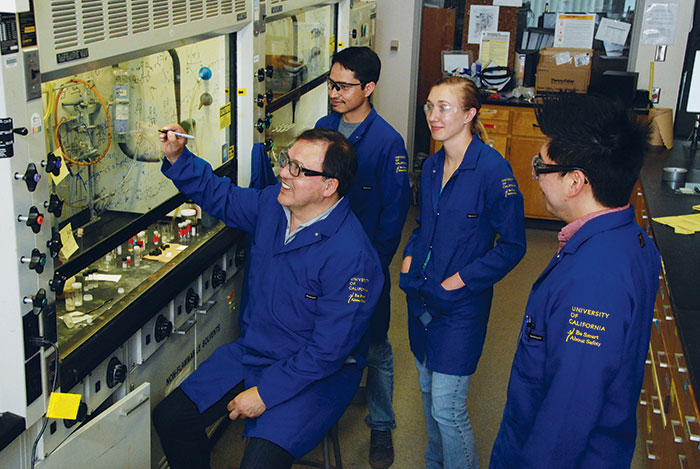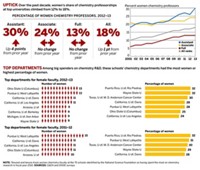Advertisement
Grab your lab coat. Let's get started
Welcome!
Welcome!
Create an account below to get 6 C&EN articles per month, receive newsletters and more - all free.
It seems this is your first time logging in online. Please enter the following information to continue.
As an ACS member you automatically get access to this site. All we need is few more details to create your reading experience.
Not you? Sign in with a different account.
Not you? Sign in with a different account.
ERROR 1
ERROR 1
ERROR 2
ERROR 2
ERROR 2
ERROR 2
ERROR 2
Password and Confirm password must match.
If you have an ACS member number, please enter it here so we can link this account to your membership. (optional)
ERROR 2
ACS values your privacy. By submitting your information, you are gaining access to C&EN and subscribing to our weekly newsletter. We use the information you provide to make your reading experience better, and we will never sell your data to third party members.
Careers
Women Are 17% Of Chemistry Faculty
After a year’s pause, gradual growth in the percentage of female chemistry professors resumes
by Sophie L. Rovner
October 30, 2011
| A version of this story appeared in
Volume 89, Issue 44
Women still hold surprisingly few chemistry professorships, although they are slowly gaining ground: The gradual expansion in women’s share of chemistry faculty positions resumed in the 2010–11 academic year after pausing the year before. At the 50 universities that spent the most on chemical research, women held 17% of the tenured and tenure-track positions in 2010–11, up from 16% in the previous two years, according to revised C&EN figures.
The weak economy may be impeding faster progress. Budget cuts resulting from the Great Recession and other financial strains have prevented many willing chemistry departments from recruiting new female professors or, for that matter, any new professors at all. And some chemistry departments tell C&EN they have been trying their darndest to recruit female faculty but have lost promising candidates to schools with more resources.
When considering faculty positions for which a chemistry department paid at least half the salary, women held 10% or less of those positions at just four of the top 50 schools. They included the University of Chicago, Emory University, and the University of Southern California. Johns Hopkins University had just one woman out of a total of 20 chemistry professors, giving it the lowest proportion of women among the schools. The brevity of the 10%-and-under list marked quite an improvement over 2009–10, when seven schools were in this category.
The University of Puerto Rico, Río Piedras, had the highest percentage of women in 2010–11. There, women held almost one-third of the faculty positions. Purdue University came in a close second, with 28% women. (If the pool of schools is expanded to the top 75, Colorado State University was the only other school with that high a percentage of female chemistry faculty.)
In absolute numbers, Purdue had the most women in its chemistry department, with 15 female faculty, followed by the University of California, Los Angeles, with 12.
C&EN has been counting women on chemistry faculties every year since 2000. For each of those years, the survey covered the schools that spent the most on chemical R&D, based on the most recent National Science Foundation ranking available in a given year. Usually, C&EN limited the survey to the top 50 schools.
Arguably, these selection criteria have some flaws. For example, NSF’s ranking makes no distinction between schools that have chemistry-only departments and those with departments that combine chemistry with another subject, such as biochemistry. Also, selecting a certain number of schools to profile excludes plenty of schools with good news to report. For instance, at school number 79—Brown University—three of the last five tenure-track hires were women, notes chemistry department chair Matthew B. Zimmt.
For this year’s story, C&EN partnered with the Open Chemistry Collaborative in Diversity Equity (OXIDE) to collect data on the schools that topped NSF’s list for 2008, the most recent year available since the survey began. Data on the top 75 schools appear in the tables in this story; data on additional schools are available on the OXIDE website (oxide.gatech.edu).
The OXIDE initiative is also gathering data on other aspects of diversity, including citizenship, race, and ethnicity. OXIDE’s objective is to try to establish diversity equity within the leading research-active chemistry departments, explains Director Rigoberto Hernandez. Hernandez, who is a chemistry professor at Georgia Institute of Technology, has served on a number of policy-making boards with the American Chemical Society (which publishes C&EN), Georgia Tech, and the National Academies to try to help achieve diversity equity.
“In any given year, schools typically hire only one or two individuals, so change is going to be incremental from year to year,” Hernandez concedes. Still, several of the schools that OXIDE looked at have hired at least one woman in the past year. He notes that “the percentages at the moment are generally between 10 and 20%, with a few happy exceptions that are above that.”
NSF data indicate that approximately 39% of chemistry graduate students in 2009 were women, Hernandez says. So he expects that women’s share of faculty positions could eventually approach or exceed that level “if the pathways to go from Ph.D. to assistant professor are equitable.” OXIDE plans to “do detailed, longitudinal assessments of whether those pathways are in fact equitable,” he adds.
“We’re hoping to change the infrastructure from the top down, so that the environment is accommodating all the way through the pipeline,” Hernandez says. “The beauty of this approach is that these types of changes tend to make it better for everyone.”
OXIDE plans to collaborate with department heads and chairs to evaluate and promote programs, interventions, and policy changes that could improve gender equity as well as other forms of diversity equity.
“What we know thus far is that affinity groups for gender tend to be effective,” Hernandez says. The most effective groups include grad students along with professors. It’s also helpful if these groups include department heads and senior administrators, regardless of gender, he adds.
One school that promotes interactions among women is Vanderbilt University. “We invite women and minority seminar speakers, not only in the chemistry seminar program, but also in seminar programs in related sciences and interdisciplinary areas of research,” notes chemistry department chair Michael P. Stone. In addition, “women faculty are represented on external advisory boards that evaluate our research programs. Thus, our women and minority students have opportunities to meet and interact with women and minority tenured and tenure-track faculty from other institutions.”
This type of interaction has also benefited Louisiana State University’s Baton Rouge chemistry department, where women now make up 20% of the tenured/tenure-track faculty. “All of our current women faculty were appointed during the last 10 years,” says chair Andrew W. Maverick. The initial recruits “were highly supportive and encouraging for the next group of interviewees.”
The chemistry department at the University of California, Irvine, has also seen a significant increase in the number of women faculty members over the past few years. “Currently more than half of our assistant professors are women, which suggests that women will play a much larger role in the department as the years go by,” according to chair Scott D. Rychnovsky.
“We have made a sincere effort to increase the mentoring of young faculty,” Rychnovsky says. “Our search pools have more women in them, and in every junior faculty search over the last few years, we have identified one or more women in the final interview pool.”
UC Irvine and several other schools attribute part of their success to the NSF-funded ADVANCE program, which is intended to increase the representation and advancement of women in academic science and engineering careers.
The university’s sister campus, UC San Diego, demonstrates its own commitment to diversity in several ways. Robert E. Continetti, chair of the chemistry and biochemistry department, heads the UC San Diego Diversity Council. Recruitment notifications are distributed as widely as possible. Search committee chairs and the department chair work with the Office of Academic Diversity & Equal Opportunity and the dean of the Division of Physical Sciences to ensure that applicant pools are as diverse as possible. Applicants are evaluated on their personal efforts to promote diversity.
Other female-friendly initiatives at UC San Diego include lactation accommodations as well as programs for child care, enrichment, and recreation. Family accommodation policies include paid childbearing leave, work accommodations during pregnancy, periods of active service with modified duties, parental leave without pay, extension of the probationary period for assistant-level faculty, deferral of merit reviews, and periods of flexible workload for assistant-level faculty, Continetti says. Elder care support and transportation services are available. Each new professor is assigned a mentor who is a faculty member.
Klaus H. Theopold, chair of the chemistry and biochemistry department at the University of Delaware, Newark, notes that “one of our female assistant professor colleagues had a child recently, and we have accommodated this happy event by freeing her from teaching in the spring semester and—upon her request—by resetting her tenure clock by one year.” If a department is serious about having women faculty, he adds, “these are the concrete measures of support that are needed.”
At the University of Illinois, Urbana-Champaign, the number of female faculty has been increasing “mainly through top-down leadership, essentially insisting that half of the hires will be women and comprising the search committee of faculty who are committed to diversity,” says chemistry department head Steven C. Zimmerman. “We also started to target women at the senior level. In the past five years we have hired four senior faculty (two men and two women). The advantage of this approach is that we secure women colleagues past the tenure hurdle.”
Schools have numerous other ways in which they support women. The University of Southern California has the Women in Science & Engineering (WiSE) resource, which provides women chemists at all levels with travel grants, research awards, hiring support, and comprehensive mentoring programs.
Pennsylvania State University recently instituted a position of associate head for equity and diversity, says Elisabeth Vose, staff assistant to the chemistry department head. Responsibilities of the position include monitoring faculty hiring practices to ensure that applicant pools match national availability; obtaining and sharing information about gender and race equity literature; increasing the number of faculty offers made to minority candidates; sitting in on promotion and tenure meetings to ensure equity; encouraging recruitment, acceptance, and matriculation of minority graduate students and postdocs; and participating in local and national workshops on gender and race issues.
When initially recruiting its two female chemistry professors, the chemistry and physics department at Louisiana State University, Shreveport, “was sensitive to two-body issues both within the university and at a sister institution—the medical school in Shreveport,” says Cynthia J. Sisson, a physicist who chairs the department. Both female chemistry professors had spouses in academia.
Another professor retired this summer and will be replaced. But “we have had no initiatives over the last year or any proposed for the near future in terms of recruiting female chemists, as there is no money for hiring—other than to fill vacancies—for the foreseeable future,” Sisson adds.
At the University of Nevada, Las Vegas, “we currently have no initiatives of any kind because of severe budget cuts in Nevada,” says chemistry chair Dennis W. Lindle. To make matters worse, “one female faculty member left in summer 2010 due to a better offer at a national lab.”
Likewise, the University of New Orleans has been in a hiring freeze for most of the time since summer 2008, says chemistry chair Matthew A. Tarr.
Even when a chemistry department has the funds available to hire a new professor and finds some promising women candidates, the search may not turn out the way the department had hoped. That’s what happened at the chemistry and physics department at the University of South Carolina, Aiken, where the tenure-track faculty is all male. When an associate professor recently retired, “the list of candidates to replace the person who left included two very qualified female candidates, both of whom had really good offers elsewhere,” says chair Monty L. Fetterolf. He would like the department to have female faculty, “but it is a tall order when the competition is so great,” he says. In addition, “there are still so few women candidates that changing the faculty numbers quickly is a real challenge.”
The University of Southern California chemistry department was hiring at the assistant professor level in each of the past four years. “We made outstanding offers to several women candidates, with strong support from USC’s Dornsife College and its Women in Science & Engineering program,” says former chair Charles E. McKenna. “Unfortunately, in all cases, they ultimately chose other institutions.” Two other searches this spring had the same result, adds Chi H. Mak, the current chair.
Sometimes, of course, the stars align without any help. “We have had success in the past few years attracting female junior faculty,” notes John Baxendale, assistant director of the chemistry and biochemistry department at the University of Texas, Austin. “However, I cannot say that it is due to a concerted diversity effort. We recruit candidates based on their research and teaching and really place little emphasis on other factors.”
Advertisement
“OXIDE is pleased to be part of the process of surveying and reporting the data on gender, but it’s important to appreciate that these problems are not silos,” Hernandez says. “The environment in which there are potential diversity inequities with respect to gender is the same environment in which there are potential diversity inequities with respect to minorities, or [sexual orientation and gender identity], or disabilities, or foreign status, or what kind of socioeconomic background you had when you were growing up.” He believes that overcoming any of these inequities “will make it better for everyone, including white males.” ◾











Join the conversation
Contact the reporter
Submit a Letter to the Editor for publication
Engage with us on Twitter